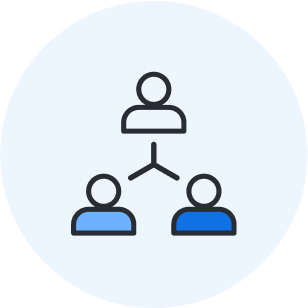
6 Operational efficiency examples to inspire your organization
Reading time: about 11 min
Topics:
Improving operational efficiency boosts competitive advantage and eliminates waste. It also benefits employees by increasing engagement and giving them more time to focus on high-value work. However, many organizations aren’t sure how to identify inefficiencies in the first place, let alone achieve any impactful improvements.
The first step to increasing operational efficiency is to visualize your current operations—which is where Lucid comes in. In this blog, we’ll cover some of the main strategies to increase operational efficiency and show you real-world examples from companies that used Lucid to implement those strategies. From visualizing existing systems to enhancing cross-functional collaboration, there are multiple ways it’s possible to boost efficiency.
What is operational efficiency?
Operational efficiency is all about optimizing business processes and resources while reducing operational costs. Companies aim to enhance collaboration and productivity as they eliminate waste, resulting in more engaged employees and customer satisfaction while improving the business’s bottom line.
While operational efficiency is in everyone’s best interest, it’s not always easy to accomplish. First, companies have to find a way to understand their existing processes so they can identify bottlenecks or dependencies and eliminate them. Increasing efficiency can also require extensive investment in employee knowledge and training. But when every aspect of a business is optimized, the stronger competitive advantage is well worth it.
What are the benefits of operational efficiency?
There are many reasons why companies—and employees—should be focused on efficiency. The benefits of operational efficiency include:
-
Reduced operating costs
-
Improved productivity as employees are able to focus on more high-value work
-
Higher customer satisfaction
-
Increased employee engagement
-
Enhanced agility and responsiveness to change
Once companies have established operational efficiency, they shouldn’t stop there. Businesses should constantly be looking for ways to enhance their efficiency as an essential aspect of continuous improvement. By constantly seeking to optimize, companies can respond to changing market conditions, adopt emerging technology, and ensure that employees remain satisfied with their roles.
How to improve operational efficiency at your company
The good news is that there are many different strategies businesses can use in order to improve their operational efficiency. Fundamentally, any strategy starts with understanding current operations, which is usually accomplished by visualizing workflows, creating timelines, or mapping existing processes. That way there’s a foundation to improve upon.
“Visualization drives operational efficiency by making invisible opportunities visible. Visualization transforms raw data into actionable insights, which accelerates decision-making, prioritization, and alignment.”
—Christopher Bailey, director of consulting services, Lucid
A few effective strategies that businesses can use to improve operational efficiency include:
-
Conducting process mapping to visualize workflows and identify areas for improvement, such as places where bottlenecks are occurring.
-
Implementing automation by adapting technology that helps replace time-consuming manual processes, like data entry.
-
Doing system modeling in order to achieve visual clarity of complex processes, such as technical systems.
-
Investing in employee training and development since it’s less expensive to retain current employees than to hire and train new ones.
-
Streamlining coordination and collaboration by eliminating unnecessary meetings, making meetings more efficient, and enabling asynchronous collaboration.
Operational efficiency examples: How Lucid has helped companies around the world improve their operational efficiency
Once businesses have identified their operational efficiency strategies, they need a platform that supports cross-functional collaboration, brainstorming, intelligent diagramming, and more. That’s where Lucid comes in, providing the visual space that companies need in order to align on and execute efficiency improvements. Check out how these six companies have used Lucid for operational efficiency.
Helping a global software company reduce manual, time-consuming tasks
With 16,000 employees located around the world, efficient collaboration and communication is crucial for this software development company. Its engineering teams rely solely on Lucid for their entire workflow, from ideation to execution. By using Lucid for brainstorming sessions, teams eliminated half a day of manual work with unique capabilities such as voting and team estimation. These capabilities helped them capture and organize team ideas in real time while increasing engagement.
Engineering teams at this company also value Lucid’s technical capabilities, such as conditional formatting, Dynamic Tables, and bi-directional syncing with Jira. Since teams no longer have to navigate between platforms to plan tasks, this has dramatically decreased the risk of manual translation errors. And, thanks to Lucid’s universal canvas, engineers have the flexibility to visualize complex technical systems while simultaneously conducting brainstorming or team planning activities.
The impact:
-
The company’s software engineering teams save six days per year by brainstorming in Lucid.
-
90% of team members are more focused in virtual meetings, leading to greater engagement and participation, versus 50% in face-to-face sessions.
-
Creating Jira tickets directly in Lucid reduces the time of issue creation from 15 minutes to two minutes.

How Lucid provides the capabilities tech teams need
Learn about the top capabilities that technical teams love to use in Lucid.
Read moreStreamlining customer research for a top multinational auto manufacturer
The innovation team at this auto manufacturer uses Lucid to produce customer journey maps that are updated in real time thanks to Lucid’s unique data-linking capabilities. Not only does Lucid help visualize the story behind the numbers, but the platform also functions as a single source of truth for multiple teams since the journey maps are a cross-functional effort. Together, six departments of the company collaborate in Lucid to understand the customer journey and pivot operations as needed, increasing alignment and saving time.
The manufacturer’s customer experience team also uses Lucid to conduct and synthesize customer interviews. By leveraging Lucid’s breakout boards feature, the team went from conducting one interview at a time to simultaneous interviews of 50 people. Then, the team used Lucid to identify and aggregate the data, passing insights on to the product team to foster continuous improvement.
The impact:
-
The manufacturer’s customer experience team is 50x more efficient in their interview data collection by using the Lucid Suite.
-
By creating a data-backed journey map in Lucid, innovation teams reduced the need for cross-functional meetings by 83%.
-
Those same journey maps helped reduce the time needed to create customer journey documentation by 98%.

How to build a single source of truth
Learn why a single source of truth is important and how to establish one for your team.
Explore our guideFacilitating Agile meetings at a top logistics company
The architecture department at this company uses Lucid to support their global strategy of continuous architecture improvement. By leveraging team hubs and revision history, architects are able to document their work as a living blueprint, easily finding and updating information when they need to. Even with thousands of applications, the team is able to collaborate on and maintain work in a way that supports their governance policy.
At this logistics company, architects are divided into Agile teams of seven that meet weekly to review their tasks and discuss updates, using Lucid to facilitate those Agile meetings. With Lucid, they’re able to centralize team resources, measure team mood, and ensure alignment. Not only are meetings more engaging, but Lucid boards also include powerful integrations and features that allow team leaders to quickly identify dependencies and other blockers that can impact their KPIs.
The impact:
-
Teams are 6x more efficient by using Lucid to structure their work and accelerate their architecture review process.
-
The architecture department saves 20 hours per week by accelerating their meeting preparations with Lucid and keeping meetings on time.
-
With a visual meeting structure, participants are 75% more engaged using Lucid during meetings, leading to higher productivity and faster decision-making.

The ultimate Agile meetings toolkit
Learn how to use visuals to boost engagement and alignment during meetings, with templates to get you started.
Learn moreImplementing process improvement to reduce waste for Delta Airlines
At Delta Airlines’ Minneapolis maintenance hub, Steve Groff was hired as a process engineer to help the company address an inefficient process for using and storing materials. Since the original process wasn’t being enforced anymore, Groff estimated that as much as 20% of Delta��’s aircraft parts weren’t being used. Groff’s task to help eliminate waste was further complicated when Delta moved its warehouse to a new physical location.
To make these big changes happen successfully, Groff needed a platform that would help him visualize, design, and implement process improvement. He also needed something that would help him build consensus on new ideas and get everyone on the same page. These needs are what led Groff to Lucid. In Lucid, he created flowcharts for employees to reference, collaboratively designed processes, and recorded feedback. He estimates that Lucid has helped the Minneapolis warehouse improve inventory accuracy, increase worker productivity, and save time and money.
"You could say that getting people to understand a process just by looking at a diagram rather than searching through written-out instructions has saved us hundreds of thousands of dollars depending on how far-reaching the process extends.”
—Steve Groff, process engineer, Delta Airlines
The impact:
-
The Minneapolis maintenance hub eliminated waste by ensuring that 100% of all aircraft parts were accounted for and put to use.
-
Meetings to discuss process improvement and generate buy-in were shortened from what used to take hours to just 20 minutes.
-
Lucid helped increase Delta’s bottom line by saving both time and money at the Minneapolis plant.

The ultimate guide to business process improvement
Get a step-by-step guide that can help you create a foundation for process improvement.
Learn moreEnabling asynchronous collaboration for a popular SaaS company
This organization, which provides consulting and professional services, has been using Lucid as a core component of its service offering. They’ve enhanced project efficiency, improved communication, and delivered more high-value client outcomes. The company also uses Lucid to host meetings, using Visual Activities to significantly increase stakeholder engagement. By ensuring all voices are heard, the company has fostered more comprehensive project scopes and has fewer changes over the course of project completion.
The data engineering team at this company has also leveraged Lucid to visualize and communicate complex database designs. By creating ERD diagrams and sharing them with cross-functional teams, they reduced project planning time and improved asynchronous communication among stakeholders. On the sales end, solution engineers used Lucid to visualize project workflows and hand off comprehensive documentation to another team, saving an average of 45 minutes per handoff and significantly increasing the overall capacity of the sales team.
The impact:
-
The organization streamlined meeting preparation by using pre-made templates in Lucid, reducing prep time by 85%.
-
By ensuring that all voices are heard during critical meetings, Lucid has enhanced stakeholder engagement for consulting teams with a 60% increase in participation rates.
-
The solution engineering team was able to save 3,900 hours per year on documentation handoffs, equating to over $280,000 in savings annually.

Get tips on assembling cross-functional teams
Get the guide on cross-functional collaboration to help improve operational efficiency.
Read nowVisualizing enterprise systems for a top Canadian life insurance company
This company in Canada saves money and time with Lucid. Its executive team creates their enterprise system roadmaps in Lucid, brainstorming ideas in Lucidspark and then drafting their system architecture proposals in Lucidchart. Its IT team also uses Lucid to map out process improvement, creating value stream maps across their process flows to identify areas of waste in their system. From there, the team can ideate on possible future states.
Using Lucid to conduct virtual meetings and asynchronous collaboration has also allowed the organization to fully shift into a hybrid workforce. Previously, the insurance company was restricted to recruiting exclusively within a certain geography. Now, by operating as a hybrid workplace, they have access to a bigger pool of talent and have also improved retention rates for existing talent, further increasing efficiency.
The impact:
-
The operations team is 20% more efficient in their work due to the asynchronous collaboration they can do in Lucid.
-
Teams reduced the time needed to provide feedback on colleagues’ work from two or three days to two or three hours—87% faster than before.
-
The new hybrid workforce is 25% more geographically diverse with the adoption of Lucid, increasing retention rates.

Using value streams to increase agility
Learn how hybrid organizations can maximize value streams to improve efficiency.
Read moreUse Lucid to enhance your organization’s operational efficiency
There are many benefits to operational efficiency, from increasing employee retention to having better responsiveness to change. No matter which strategy you choose to use for your operational efficiency, Lucid’s here to help your organization visualize existing processes and streamline coordination. From boosting asynchronous collaboration to supporting a hybrid workforce, Lucid has everything you need to ensure you’re optimizing your business’s processes and resources. Try Lucid for your organization to see how you can improve coordination and efficiency, no matter your industry.

Book a demo today
Request a demo and see how Lucid can help you achieve better business results.
Start nowAbout Lucid
Lucid Software is a pioneer and leader in visual collaboration dedicated to helping teams build the future. With its products—Lucidchart, Lucidspark, and Lucidscale—teams are supported from ideation to execution and are empowered to align around a shared vision, clarify complexity, and collaborate visually, no matter where they are. Lucid is proud to serve top businesses around the world, including customers such as Google, GE, and NBC Universal, and 99% of the Fortune 500. Lucid partners with industry leaders, including Google, Atlassian, and Microsoft. Since its founding, Lucid has received numerous awards for its products, business, and workplace culture. For more information, visit lucid.co.
Related articles
How 7 companies use Lucid to improve Agile processes and increase efficiency
Check out how Lucid helped these seven companies enhance their agility and efficiency.
Improving operational efficiency in the public sector with Lucid
Efficiency requires modern collaboration. Learn how to streamline processes, align on decisions, and save hours on documentation.
A step-by-step guide to business process improvement
How do you go beyond the methodologies and create real change? It’s time to learn the process of process improvement.
How value streams increase agility for hybrid organizations
Learn how leaders who embrace value streams can accelerate their organization’s agile transformation in this blog by Jeff Rosenbaugh, Sr. Director of Professional Services, Lucid.
